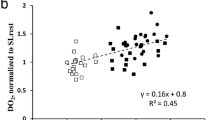Abstract
A mathematical analysis of the process of gas exchange in the lung is presented taking into account the transport mechanisms of molecular diffusion, convection and facilitated diffusion of the species due to haemoglobin. Since the rate at which blood gets oxygenated in the pulmonary capillaries is very fast, it is difficult to set up an experimental study to determine the effects of various parameters on equilibration rate. The proposed study is aimed at determining the effects of various physiological parameters on equilibration rate in pathological conditions.
Among the significant results are that 1. dissolved oxygen takes longer to achieve equilibration across the pulmonary membrane and carbon dioxide attains equilibration faster, 2. the equilibration length increases with increase in blood velocity, haemoglobin concentration, calibre of pulmonary capillaries and fall in alveolar PO2, 3. the alveolar PCO2 and forward and backward reaction rates of haemoglobin with CO2 do not materially affect the equilibration rate or length. 4. At complete equilibration, by the end of the pulmonary capillary 92% of the total haemoglobin has combined with oxygen and 8% free pigment is left which is present as carbamino haemoglobin, met haemoglobin, carboxy haemoglobin etc.
These results are of some importance for anaemic conditions, muscular exercise, meditation, altitude physiology, hypo-ventilation, hyperventilation, etc.
Similar content being viewed by others
Abbreviations
- H+ :
-
hydrogen ion
- O2 :
-
oxygen
- CO2 :
-
carbondioxide
- HbO2 :
-
oxyhaemoglobin
- HbCO2 :
-
carbaminohaemoglobin
- PO2 :
-
partial pressure of O2
- PCO2 :
-
partial pressure of CO2
- PaO2 :
-
O2 tension in arterial blood
- PaCO2 :
-
CO2 tension in arterial blood
- k1 :
-
forward rate constant for Eq. (1)
- k2 :
-
backward rate constant for Eq. (1)
- m1 :
-
forward rate constant for Eq. (2)
- m2 :
-
backward rate constant for Eq. (2)
- k:
-
equilibration rate
- a:
-
radius of the capillary
- Q:
-
velocity of blood
- L:
-
length of the capillary
- D0 :
-
diffusion coefficient of O2
- Dc :
-
diffusion coefficient of CO2
- DH :
-
diffusion coefficient of Hb
- H:
-
total haemoglobin concentration
- A:
-
matrix
- c1 :
-
concentration of dissolved O2 in blood
- c2 :
-
concentration of HbO2 in blood
- c3 :
-
concentration of dissolved CO2 in blood
- c4 :
-
concentration of HbCO2 in blood
- c5 :
-
concentration of haemoglobin
- c1alv :
-
concentration of O2 in the alveolar region
- c3alv :
-
concentration of CO2 in the alveolar region
- civen :
-
concentration of the ith species in venous blood
- ciart :
-
concentrations of the ith species in arterial blood
- F ′is :
-
concentrations of the species in dimensionless form
- J0, I0 :
-
Bessel's functions
- PalvO2 :
-
tension of O2 in alveolar region
- PalvCO2 :
-
tension of CO2 in alveolar region.
References
Adair, G. S.: The oxygen dissociation curve of haemoglobin. J. Biol. Chem. 63, 529–545 (1925)
DeHaven, J. C., DeLand, E. C.: Rand Memorandum RM-3217-PR, Rand Corp.: Santa Monica, Calif. In: Transport phenomena in medicine and biology (L.-M. Shing, ed.) New York: John Wiley 1975
Fitz-Gerald, J. M.: The mechanics of blood flow. In: Cardiovascular fluid mechanics, Vol. 2 (D.H. Bergel, ed.) London: Academic Press 1972
Gibson, Q. H.: The kinetics of reactions between haemoglobin and gases. In: Progress in biophysics and biophysical chemistry (J. A. V. Butler, B. Katz eds.) 9, 1959
Hill, E. P., Power, G. G., Longo, L. D.: Mathematical simulation of pulmonary O2 and CO2 exchange. Am. J. Physiol. 224, 904–917 (1973)
Hlastala, M. P.: A model of fluctuating alveolar gas exchange during the respiratory cycle. Resp. Physiol. 15, 214–232 (1972)
Murray, J. D.: On the molecular mechanism of facilitated oxygen diffusion by haemoglobin and myglobin. Proc. Roy. Soc. London B178, 95–110 (1971)
Paintal, A. S.: Vagal sensory receptors and their reflex effects. Physiol. Rev. 53 (1973)
Roughton, F. J. W., Forster, R. E.: Relative importance of diffusion and chemical reaction rates in determining rate of exchange of gases in the human lung, with special reference to true diffusing capacity of pulmonary membrane and volume of blood in the lung capillaries. J. Appl. Physiol. 11, 290–302 (1957)
Singh, M. P., Sinha, P. C., Meena Aggarwal: Facilitated diffusion of O2 and CO2 in the presence of haemoglobin. Med. & Life Sciences Engg. 4 (3) (1978)
Ulanowicz, R. E., Frazier, G. C.: The transport of oxygen and carbondioxide in haemoglobin systems. Math. Biosci. 7, 111–129 (1970)
Wittenberg, J. B.: The molecular mechanism of haemoglobin-facilitated oxygen diffusion. J. Biol. Chem. 241, 104–114 (1966)
Yamamoto, W. S.: Mathematical analysis of the time course of alveolar CO2 variations. J. Appl. Physiol. 15, 315–319 (1960)
Author information
Authors and Affiliations
Rights and permissions
About this article
Cite this article
Singh, M.P., Khetarpal, K. & Sharan, M. A theoretical model for studying the rate of oxygenation of blood in pulmonary capillaries. J. Math. Biology 9, 305–330 (1980). https://doi.org/10.1007/BF00276496
Received:
Revised:
Issue Date:
DOI: https://doi.org/10.1007/BF00276496




